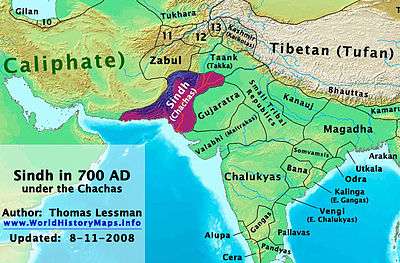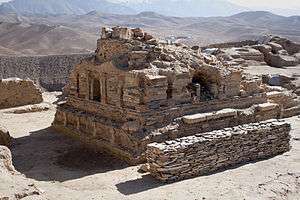Zunbils
Zunbil, also written as Zhunbil, was a royal dynasty south of the Hindu Kush in present southern Afghanistan region. They ruled from the early 7th century until the Saffarid conquest in 870 AD. The Zunbils are believed to be an offspring of the southern-Hephthalite rulers of Zabulistan.[1] The dynasty was related to the Turk Shahis of the northeast in Kabul.[2] They are described as having Turkish troops in their service by Arabic sources like Tarikh al-Tabari and Tarikh-i Sistan.[3]


The faith and cult of this community has been little researched. According to the interpretation of Chinese sources by Marquarts and de Groots in 1915, the king of Ts'ao is said to have worn a crown with a golden fish head and was related to the Sogdians. The Temple of the Zun was recognizable by a large fish skeleton on display; this would indicate a related merchantry deity[4]. In addition to that Marquarts states the Zunbils to have worshipped a solar deity which might have been connected to Aditya (Surya). However, according to Shōshin Kuwayama there was a clear dichotomy between worshipers of the Hindu god Surya and followers of the cult of Zhun. This is exemplified by the conflict between Surya and Zhun followers, which lead to the followers of Zhun migrating southwards towards Zabulistan from Kapisa.[5] According to André Wink the cult of this god was primarily Hindu, though parallels have also been noted with pre-Buddhist religious and monarchy practices in Tibet and had Zoroastrian influence in its ritual.[6][7]
Their territory included between what is now the city of Zaranj in southwestern Afghanistan and Kabulistan in the northeast, with Zamindawar and Ghazni serving as their capitals.[8] The title Zunbil can be traced back to the Middle-Persian original Zūn-dātbar, 'Zun the Justice-giver'. The geographical name Zamindawar would also reflect this, from Middle Persian 'Zamin-i dātbar' (Land of the Justice-giver).[9]
History

According to Anthony McNicoll, "the Zunbils ruled in the Kandahar area for nearly 250 years until the late 9th century AD".[10] Their main capital Zamindawar was located in the present-day Helmand Province of Afghanistan. The shrine of Zoon was located about three miles south of Musa Qala in Helmand, which may still be traced today. Some believe that the Sunagir temple mentioned by the famous Chinese traveler Xuanzang in 640 AD pertains to this exact house of worship.[11]
In 653-4 AD, an army of around 6,000 Arabs were led by General Abdur Rahman bin Samara and they arrived to the shrine of Zoon in Zamindawar. It is reported that General Abdur Rahman "broke off a hand of the idol and plucked out the rubies which were its eyes in order to persuade the Marzbān of Sīstān of the god's worthlessness."[12] The General explained to the Marzbān: "my intention was to show you that this idol can do neither any harm nor good."[13] In 698 Ubayd Allah b. Abi Bakra lead the 'Army of Destruction' against the Zunbils and was defeated. About 700 Ibn al-Ash'ath tried again with the 'Peacock Army' which led to a mutiny.[14]
Saffarid and Zunbil struggles
C.E. Bosworth writes that:
One of the most important aspects of early Saffarids policy of significance for the spread of Islam in Afghanistan and on the borders of India long after their empire had collapsed was that of expansion into east Afghanistan. The early Arab governors of Sistan had at times penetrated as far as Ghazna and Kabul, but these had been little more than slave and plunder raids. There was a fierce resistance from the local rulers of these regions, above all from the line of Zunbils who ruled in Zamindavar and Zabulistan and who were probably epigoni of the southern Hepthalite or Chionite kingdom of Zabul; on more than one occasion, these Zunbils inflicted sharp defeats on the Muslims. The Zunbils were linked with the Turk-Shahs of the Turk Shahi dynasty; the whole river valley was at this time culturally and religiously an outpost of the Indian world, as of course it had been in the earlier centuries during the heyday of the Buddhist Gandhara civilization.[15]
Religion
The Zunbils worshiped the Zhuna, possibly a sun god connected to the Hindu god Surya and is sometimes referred to as Zoor or Zoon. He is represented with flames radiating from his head on coins. Statues were adorned with gold and used rubies for eyes. Huen Tsang calls him "sunagir".[11] It has been linked with the Hindu god Aditya at Multan, pre-Buddhist religious and kingship practices of Tibet as well as Shaivism.[7]
His shrine lay on a sacred mountain in Zamindawar. Originally it appears to have been brought there by Hepthalites, displacing an earlier god on the same site. Parallels have been noted with the pre-Buddhist monarchy of Tibet, next to Zoroastrian influence on its ritual. Whatever its origins, it was certainly superimposed on a mountain and on a pre-existing mountain god while merging with Shaiva doctrines of worship.[6]
Others however have connected Zun with the Sassanid Zoroastrian God Zurvān, the God of time.
"Regarding origin of Žuna, Xuanzang had only mentioned that it was initially brought to Kapisa, later Begram from “far” and later moved to Zabul. There is no consensus as to who brought it and when. By identifying Žun with Sassanian Zurvān, the cult of Žun or*Zruvān can be viewed in a much wider context of Iranian history and religious developments. Žun, Like Zurvān, most likely represented the "god of time", a heresy in Zoroastrianism, which originated in response to the religious reforms introduced during second half of Achaemenid Empire. The cosmopolitan nature of the god is consistent with the variety of religions practiced in the region prior to the Islamization of Afghanistan."[16]
See also
- Islamic conquest of Afghanistan
- Pre-Islamic period of Afghanistan
- Religion in Afghanistan
References
- Andre Wink, Al-Hind, the Making of the Indo-Islamic World, Vol.1, (Brill, 1996), 115;""The Zunbils of the early Islamic period and the Kabulshahs were almost certainly epigoni of the southern-Hephthalite rulers of Zabul."
- History of Civilizations of central Asia, B A Litivinsky Zhang Guang-Da, R Shabani Samghabadi, p.376
- Raphael Israeli, Anthony Hearle Johns (1984). Islam in Asia: South Asia. Magnes Press. p. 15.
- H. Miyakawa und A. Kollautz: Ein Dokument zum Fernhandel zwischen Byzanz und China zur Zeit Theophylakts In: Byzantinische Zeitschrift, S. 14 (Anhang). De Gruyter Januar 1984. ISSN 1868-9027.
- https://repository.kulib.kyoto-u.ac.jp/dspace/bitstream/2433/48769/1/34%281%29_25.pdf
- Al- Hind: The slave kings and the Islamic conquest - Volume I. Brill. pp. 118, 119.
- Clifford Edmund Bosworth (1977). The Medieval History of Iran, Afghanistan, and Central Asia. Variorum Reprints. p. 344.
- André Wink, "Al-Hind: The Making of the Indo-Islamic World", Brill 1990, p. 118
- Bosworth, Clifford Edmund. 2002. The Encyclopaedia of Islam. Leiden: Brill. Zamindawar. p.439.
- Excavations at Kandahar 1974 & 1975 (Society for South Asian Studies Monograph) by Anthony McNicoll
- "The Temple of Zoor or Zoon in Zamindawar". Abdul Hai Habibi. alamahabibi.com. 1969. Retrieved August 14, 2012.
- André Wink, "Al-Hind: The Making of the Indo-Islamic World", Brill 1990. p 120
- "Amir Kror and His Ancestry". Abdul Hai Habibi. alamahabibi.com. Retrieved August 14, 2012.
- Hugh Kennedy,The Great Arab Conquests',2007, pages 194-198
- The Tahirids and Saffarids, C.E.Bosworth,The Cambridge History of Iran:From the Arab Invasion to the Saljuqs, Vol. IV, Ed. Richard Nelson Frye, William Bayne Fisher and John Andrew Boyle, (Cambridge University Press, 1975), 111. ISBN 0-521-20093-8, ISBN 978-0-521-20093-6
- https://www.academia.edu/38605352/Etymology_of_Zhunbil_and_Identity_of_the_Rulers_of_Kabul_and_Zabul_in_Seventh_-Ninth_Centuries_C.E
External links
Notes
- 1.^ "Xuanzang's story is simple , but suggests a historical background:there happened a conflict between the two religious groups, the Surya group and the Zhuna group".